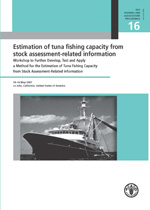|
Bayliff, W.H.; Majkowski, J. (eds.)
Estimation of tuna fishing capacity from stock assessment-related information:
Workshop to Further Develop, Test and Apply a Method for the Estimation of Tuna Fishing Capacity from Stock Assessment-Related Information. La Jolla, California, United States of America, 14–16 May 2007.
FAO Fisheries and Aquaculture Proceedings. No. 16. Rome, FAO. 2009. 53p.
ABSTRACT
These Proceedings include (i) the Report of and (ii) the paper presented at the Workshop
to Further Develop, Test and Apply a Method for the Estimation of Tuna Fishing
Capacity from Stock Assessment-Related Information. The Workshop was hosted
by the Inter-American Tropical Tuna Commission (IATTC) in La Jolla, California,
USA, from 14 to 16 May 2007. It was organized by FAO�s Japan-funded Project on
the �Management of Tuna Fishing Capacity: Conservation and Socio-Economics�
in collaboration with and with in-kind support of several international and national
fisheries institutions involved tuna fisheries research and management.
The paper presented at the Workshop describes peak-to-peak (PP) and general
additive modeling (GAM) approaches to estimate fishing capacity and related quantities
from stock assessment information. The PP and GAM methods were applied to seven
stocks of bigeye, yellowfin and skipjack tuna of the Pacific, Indian and Atlantic Oceans.
The estimated trends in overcapacity with both methods were consistent across most of
the stocks, showing increasing trends at the beginning of the time series and reaching
maximum values during the late 1990s, followed by decreasing trends after that. For
most of the stocks analyzed, overcapacity was positive during a part of the time series.
Sensitivity tests revealed greater estimates of capacity output when the stock assessment
data were most disaggregated. Further tests revealed that the estimates of overcapacity
were lower when low variability in effort deviations was permitted in the stock
assessment.
The Report of the Workshop outlines the discussions carried out at the Workshop, some
proposals for further research, recommendations and conclusions of the Workshops.
|

